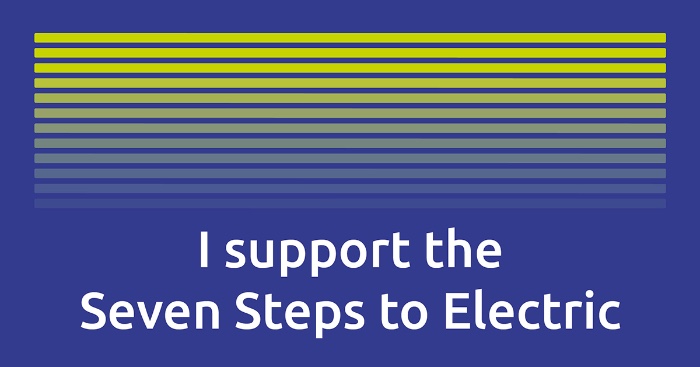Manifesto for Electro-Mobility
The Electric Vehicle Association Scotland has identified seven steps which could be taken by the Scottish Government, and supported by the Parliament, which would give fast and genuine impetus to the meeting of our key aim: placing Scotland at the forefront of e-mobility innovation and ambition.
- 1. Create a charging infrastructure, by 2025, sufficient to service a market where all new cars and vans are electric.
- EVA Scotland believes that Scotland has the ambition and resources to lead the way in the UK for the adoption of electric vehicles. In truth, government targets for phasing out sales are less important than the trajectory of the EV market, which is likely to have largely achieved this by 2025. To complement this, EVA Scotland would like the next Scottish Government to commit to the installation of sufficient charging capacity by 2025 to service a market where all new sales of cars and vans are electric.
- 2. Provide additional funding to support the Switched On Towns and Cities Challenge Fund to create 50 electric towns and cities by 2025.
- The Switched On Towns and Cities Challenge Fund supports intensive, high impact capital activity to incentivise and promote the use of plug-in electric vehicles. The key aim is to encourage uptake of EV use. EVA Scotland supports this initiative as a driver in facilitating the shift towards electric, but believes Scotland needs to be more ambitious in its targets. As a minimum, EVA Scotland would like to see at least 50 towns and cities recognised with Switched On status by 2025.
- 3. Adopt specific targets to move towards electrification of Scotland’s buses, coaches, railways, ferries, freight and internal flights.
- The electric vehicle revolution goes beyond cars and vans. EVA Scotland believes the Scottish Government must adopt ambitious targets, and accelerate existing ones, to encompass all modes of transport in the shift to a renewable-powered transport system. Specific targets include:
- All buses should be electric or net zero carbon by 2030;
- Following the example set by Ember on the Edinburgh Dundee route, all intercity coach journeys should be electric or net zero carbon by 2030;
- Decarbonise all urban, suburban and commuter rail travel by 2030;
- Accelerate the modal shift from HGV to electric rail freight;
- Accelerate the 2040 target for making the Highlands and Islands the first net zero (carbon emissions) aviation region to 2035;
- For ferries in Scottish Government ownership, increase the target from 30% low carbon by 2032 to 50% low carbon; and
- Adopt a holistic approach to reducing vehicle numbers by encouraging alternatives such as e-bikes, e-scooters, e-cargo bikes etc.
- 4. Create a new ‘road pricing’ system to replace Vehicle Excise Duty and Fuel Duty.
- Vehicle Excise Duty and Fuel Duty are made for a world of internal combustion vehicles; not for the electric world we wish to live in. These tax powers are currently reserved by the Scotland Act; whomever forms the next Scottish Government should request the devolution of both taxes before abolishing them and replacing them with a system whereby charges are dependent on where you drive, when you drive and how often you drive.
- 5. Lobby the UK Government to abolish VAT on the purchase of new electric vehicles.
- In order to accelerate behavioural change towards electric vehicle adoption, bold measures are needed to incentivise the shift including VAT being excluded on new electric car sales. Currently, VAT can only be reclaimed on electric company cars, purely for business use but nothing for private use. A similar scheme in Norway has helped propel pure battery electric vehicles to a near 50% share of new car sales. EVA Scotland wants to see the sale of electric vehicles made more attractive by excluding VAT to bring the cost down, and urges whichever party forms the next Scottish Government to formally request this of the UK Government.
- 6. Improve access for all disabled drivers to the ChargePlace Scotland charging network. Support vehicle modifications and wireless charging infrastructure to facilitate.
- Disabled drivers should not face discrimination when making the switch to electric. Current infrastructure does not support disabled drivers charging their vehicles as easily as able bodied drivers and while the technology is there, it’s not widely used. EVA Scotland would like to see a commitment from the next Scottish Government to include disabled access to charging infrastructure.
- 7. Right to Plug.
- The right to plug involves removing barriers which prevent consumers switching to electric and making it as easy and convenient as possible to charge an electric vehicle. To this end, EVA Scotland would like building regulations to be altered to require new developments to incorporate charge points for all new homes with provision of charge points for communal and visitor parking. Furthermore, we would like to see amendments made to the Tenements (Scotland) Act 2004 to ensure a tenant or co-owner can install a charging point without having to obtain potentially difficult consent.

